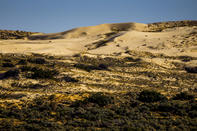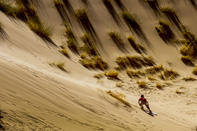Unique Ecosystem
Witsand has been a hub of human activity since time immemorial, with a number of Stone-Age sites dated back to between the 17th and 19th centuries by archaeologists. Pastoralist Koranna people first settled here, but eventually made way for first the Tswana people, and eventually the initial European settlers.
Throughout 40,000 years of human habitation, the ecosystem at Witsand remained relatively unchanged, but critical damage to the dune vegetation accelerated as the grazing pressure increased from the 1950s onwards. Eventually, in 1993/94 the area was proclaimed a protected zone by the then provincial government of the Cape Province.
Witsand is a pretty unique place as far as desert ecosystems go, boasting a convergence of three major vegetation biomes. Karroid Kalahari Bushveld, typical with its camel thorns and shepherds’ trees, blends with Orange River Nama-Karoo (black thorn, thorn tree and silky Bushman’s grass) and finally Kalahari Mountain Bushveld against the higher ridges (camphor trees, kunibush, iron grass, finger grass, etc.).
The reserve is home to the famous ‘Brulsand’ or Roaring Sands of the Kalahari, and when disturbed by wind, man or animal, these dunes emit an eerie, roaring sound. The vibration occurs in the hot dry months between September and April, and you need to be close to the actual dunes to hear the rumbling sound.

